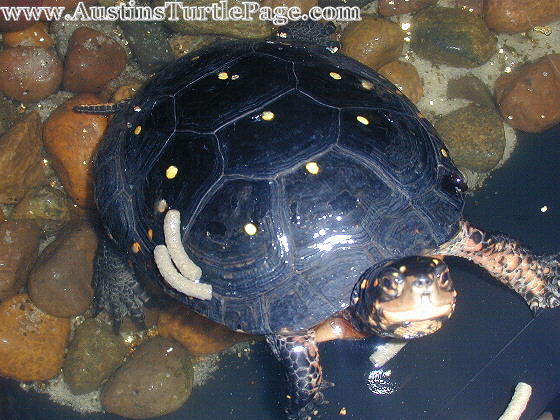By Beth & Patrick
|
 |
|
"Berry" Pic
courtesy of Beth & Patrick |
Clemys guttata
Male 31/2
to 5 inches
Female
31/2
to 5 inches
Maximum recorded length was 5.4 inches
Most spotted turtle hatchings and
younger spotteds love to eat worms, baby or small worm like red wigglers, or
small night crawlers and pretty much anything offered to them. The older the
spotteds get, they will eat about anything from aquatic vegetation like anachris
to insects like crickets; all foods are consumed in the water; although, the
adult spotteds when finding food like red wiggler or night crawlers will find
them on land then drag the food to the water and consume it in the water. During
hibernation the spotteds will eat mostly just worms they find in the wild, for
example red wigglers. When they come out of hibernation they will eat about
anything giving to them, such as crickets, other insects, worms, snails, aquatic
plants, crayfish and sometimes algae.
Air Temperature:
Low to mid 80's
Basking Temperature:
95°
Water Temperature:
Low 70's
The spotted
turtles are found around shallow low water areas. Spotteds can be found in
shallow marshy water areas. Baby and young spotted turtles are mostly going to
be found in low level water areas. But the older they get the more the spotted
will seek land more often. They will be often found in marshy meadows, bogs,
swamps, ponds, ditches, and most they will be around an area with relatively
still water.
Spotteds
will range from the low Maine area all the way down to mid to central Florida.
The states will include: Maine, Vermont, New Hampshire, Massachusetts, Rhode
Island, Connecticut, New York, Pennsylvania, New Jersey, Delaware, Maryland,
West Virginia, Virginia, North Carolina, South Carolina, Georgia, Florida, and
around the great lakes area.
Yes
The
spotteds captive habitat is pretty simple. If you want to make it as close to
their natures wild life habitat then you will have to have a 50/50 land and
water. This will include: drift wood, river rock, slate rock, dirt, and aquatic
plants. Spotted Turtles like to bask so there will have to be a basking spot.
Also UVB lightning is needed and also a heat light for their basking area. You
will not have to have a heater do to the fact that they live in extremely cold
water and they will not go into the water if it is too hot, but it depend if you
have this turtle out doors in the winter then you might want to have a little
heater to have the water at the low 70’s. These turtle aren’t good swimmer so
the maximum water depth should not exceed the depth of 6 inch. Substrate should
be the following: Sand, dirt, and small to medium rocks.
The
recommended size enclosure should be a 55 gallon tank or stock tank. You can
easily fit a 3 spotteds in a 55 gallon stock tank or aquarium. The reason for
this is that some will be on the land and some will be in the water so they
wouldn’t take the space of the other spotteds, but another reason for this is
that they are a very small species. This will also give a good amount of water
and land for the turtles. The only downside to using sand is that you will have
to watch out for sand granules affecting the pump. With spotteds they need water
to be still to accommodate their wild life habitats, so just circulate the water
with an adequate filter.
In
captivity the spotted will consume the same as their diet in the wild. The
hatchlings and the younger turtle will eat just about anything you will hand
them, so snail, worms (red wigglers) (night Crawlers), crickets, other insects,
and aquatic vegetation, veggies, also spotted love Reptomin and Mazuri.
Wood
turtle, Bog turtle, other Spotteds.
They aren’t
the best of swimmers do to the fact that they have small web feet. They are a
smaller and skinnier species of turtles. They love shady areas also to cool down
without going into the water all the time.